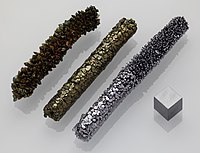
Photo from wikipedia
Coal combustion is a major energy source in the US. The solid waste product of coal combustion, coal combustion residue (CCR), contains potentially toxic trace elements. Before 1980, the US… Click to show full abstract
Coal combustion is a major energy source in the US. The solid waste product of coal combustion, coal combustion residue (CCR), contains potentially toxic trace elements. Before 1980, the US primarily disposed of CCR in aquatic settling basins. Animals use these basins as habitat and can be exposed to CCR, potentially affecting their physiology. To investigate the effects of CCR on eastern mud turtles (Kinosternon subrubrum), we sampled 30 turtles exposed to CCRs and 17 unexposed turtles captured in 2015-2016 from the Savannah River Site (Aiken, SC, USA). For captured turtles, we (1) quantified accumulation of CCR in claw and blood samples, (2) used bacterial killing assays to assess influences of CCR on immune responses, (3) compared hemogregarine parasite loads, and (4) compared metabolic rates via flow-through respirometry between CCR-exposed and unexposed turtles when increased temperature was introduced as an added stressor. Turtles exposed to CCR accumulated CCR-associated trace elements, corroborating previous studies. Blood Se and Sr levels and claw As, Se, and Sr levels were significantly higher in turtles from contaminated sites. Average bacterial killing efficiency was not significantly different between groups. Neither prevalence nor average parasite load significantly differed between CCR-exposed and reference turtles, although parasite load increased with turtle size. Regardless of site, temperature had a significant impact on turtle metabolic rates; as temperature increased, turtle metabolic rates increased. The effect of temperature on turtle metabolic rates was less pronounced for CCR-exposed turtles, which resulted in CCR-exposed turtles having lower metabolic rates than reference turtles at 30 and 35 °C. Our results demonstrate that turtles accumulate CCR from their environment and that accumulation of CCR is associated with changes in turtle physiological functions when additional stressors are present.
Journal Title: Environmental pollution
Year Published: 2018
Link to full text (if available)
Share on Social Media: Sign Up to like & get
recommendations!